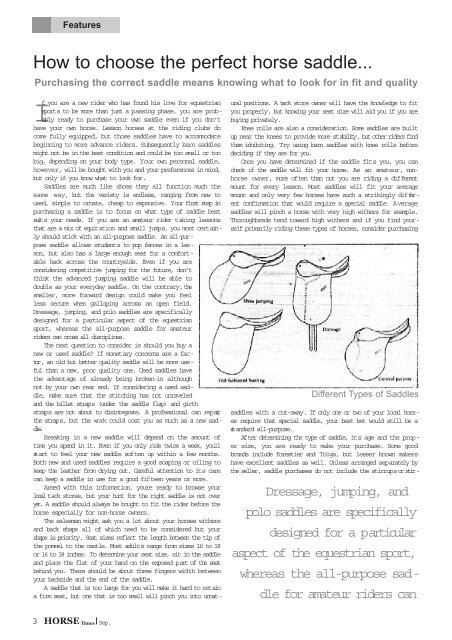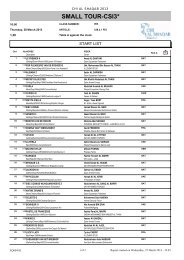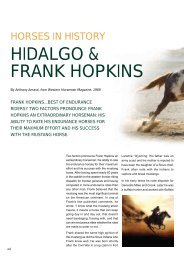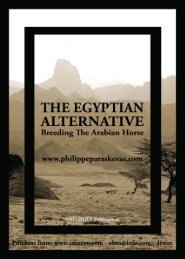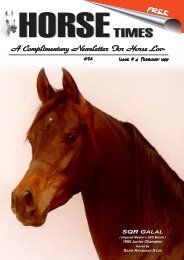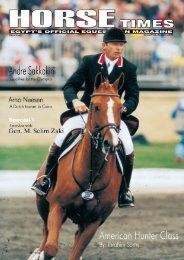You also want an ePaper? Increase the reach of your titles
YUMPU automatically turns print PDFs into web optimized ePapers that Google loves.
3<br />
Features<br />
How to choose the perfect horse saddle...<br />
Purchasing the correct saddle means knowing what to look for in fit and quality<br />
If you are a new rider who has found his love for equestrian<br />
sports to be more than just a passing phase, you are probably<br />
ready to purchase your own saddle even if you don’t<br />
have your own horse. Lesson horses at the riding clubs do<br />
come fully equipped, but those saddles have to accommodate<br />
beginning to more advance riders. Subsequently barn saddles<br />
might not be in the best condition and could be too small or too<br />
big, depending on your body type. Your own personal saddle,<br />
however, will be bought with you and your preferences in mind,<br />
but only if you know what to look for.<br />
Saddles are much like shoes they all function much the<br />
same way, but the variety is endless, ranging from new to<br />
used, simple to ornate, cheap to expensive. Your first step in<br />
purchasing a saddle is to focus on what type of saddle best<br />
suits your needs. If you are an amateur rider taking lessons<br />
that are a mix of equitation and small jumps, you most certainly<br />
should stick with an all-purpose saddle. An all-purpose<br />
saddle allows students to pop fences in a lesson,<br />
but also has a large enough seat for a comfortable<br />
hack across the countryside. Even if you are<br />
considering competitive jumping for the future, don’t<br />
think the advanced jumping saddle will be able to<br />
double as your everyday saddle. On the contrary, the<br />
smaller, more forward design could make you feel<br />
less secure when galloping across an open field.<br />
Dressage, jumping, and polo saddles are specifically<br />
designed for a particular aspect of the equestrian<br />
sport, whereas the all-purpose saddle for amateur<br />
riders can cross all disciplines.<br />
The next question to consider is should you buy a<br />
new or used saddle? If monetary concerns are a factor,<br />
an old but better quality saddle will be more useful<br />
than a new, poor quality one. Used saddles have<br />
the advantage of already being broken-in although<br />
not by your own rear end. If considering a used saddle,<br />
make sure that the stitching has not unraveled<br />
and the billet straps (under the saddle flap) and girth<br />
straps are not about to disintegrate. A professional can repair<br />
the straps, but the work could cost you as much as a new saddle.<br />
Breaking in a new saddle will depend on the amount of<br />
time you spend in it. Even if you only ride twice a week, youll<br />
start to feel your new saddle soften up within a few months.<br />
Both new and used saddles require a good soaping or oiling to<br />
keep the leather from drying out. Careful attention to its care<br />
can keep a saddle in use for a good fifteen years or more.<br />
Armed with this information, youre ready to browse your<br />
local tack stores, but your hunt for the right saddle is not over<br />
yet. A saddle should always be bought to fit the rider before the<br />
horse especially for non-horse owners.<br />
The salesman might ask you a lot about your horses withers<br />
and back shape all of which need to be considered but your<br />
shape is priority. Seat sizes reflect the length between the tip of<br />
the pommel to the cantle. Most adults range from sizes 16 to 18<br />
or 16 to 18 inches. To determine your seat size, sit in the saddle<br />
and place the flat of your hand on the exposed part of the seat<br />
behind you. There should be about three fingers width between<br />
your backside and the end of the saddle.<br />
A saddle that is too large for you will make it hard to retain<br />
a firm seat, but one that is too small will pinch you into unnat-<br />
HORSE <strong>Times</strong> Sep.<br />
ural positions. A tack store owner will have the knowledge to fit<br />
you properly, but knowing your seat size will aid you if you are<br />
buying privately.<br />
Knee rolls are also a consideration. Some saddles are built<br />
up near the knees to provide more stability, but other riders find<br />
them inhibiting. Try using barn saddles with knee rolls before<br />
deciding if they are for you.<br />
Once you have determined if the saddle fits you, you can<br />
check if the saddle will fit your horse. As an amateur, nonhorse<br />
owner, more often than not you are riding a different<br />
mount for every lesson. Most saddles will fit your average<br />
mount and only very few horses have such a strikingly different<br />
confirmation that would require a special saddle. A verage<br />
saddles will pinch a horse with very high withers for example.<br />
Thoroughbreds tend toward high withers and if you find yourself<br />
primarily riding these types of horses, consider purchasing<br />
Different Types of Saddles<br />
saddles with a cut-away. If only one or two of your local horses<br />
require that special saddle, your best bet would still be a<br />
standard all-purpose.<br />
After determining the type of saddle, its age and the proper<br />
size, you are ready to make your purchase. Some good<br />
brands include forestier and Tolga, but lesser known makers<br />
have excellent saddles as well. Unless arranged separately by<br />
the seller, saddle purchases do not include the stirrups or stir -<br />
Dressage, jumping, and<br />
polo saddles are specifically<br />
designed for a particular<br />
aspect of the equestrian sport,<br />
whereas the all-purpose saddle<br />
for amateur riders can


